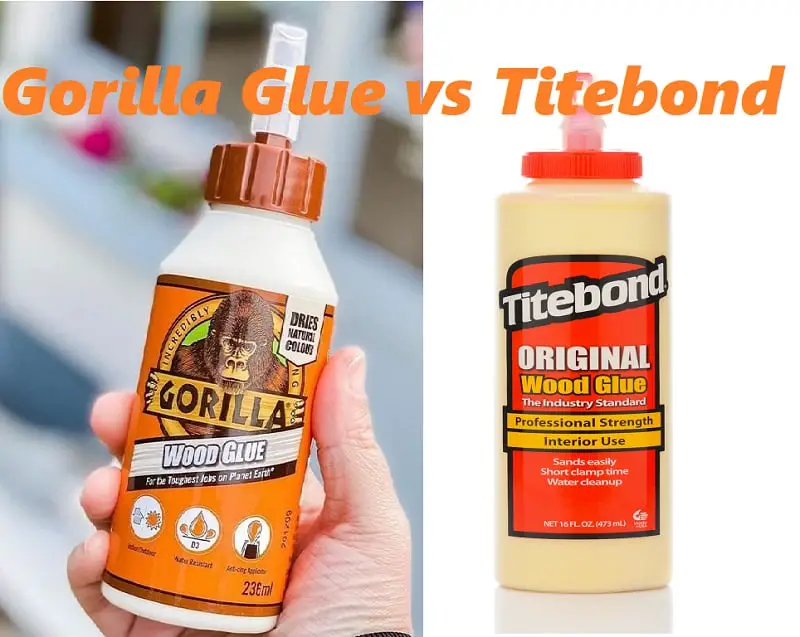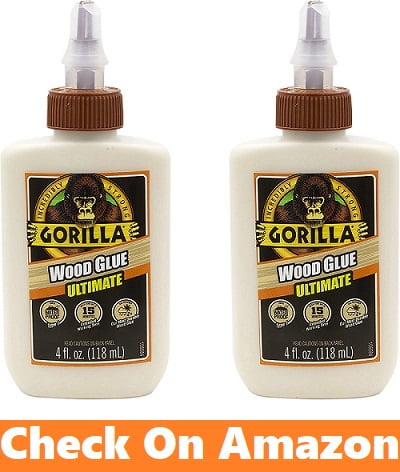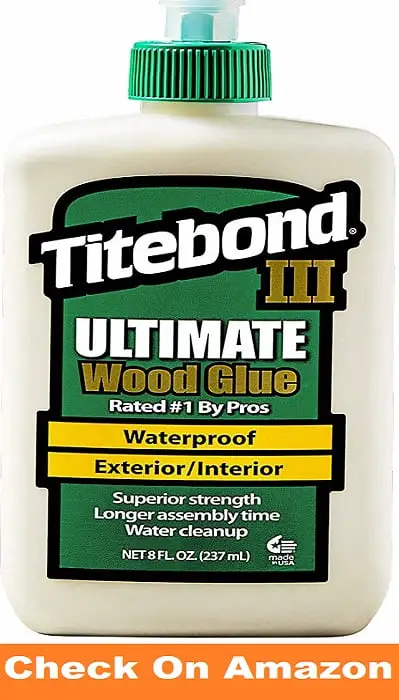
Gorilla and Titebond are two of the most reliable wood adhesive producers in the market. But if your furniture is broken or you are working on a new wood project, which one will I choose? To know the answer, you need to understand the differences between Gorilla Wood Glue vs Titebond.
The main difference between the Gorilla Wood Glue and Titebond is their strength. Titebond is super strong, which makes it a better choice for larger heavy-duty works. Gorilla Wood Glue also creates a strong bond but is better suited to lighter works.
Plus, they have several other differences, such as clamp time, durability, colors, and more. Let’s discuss the differences in detail to pick one adhesive between Titebond and Gorilla Wood Glue for your next project.
Gorilla Wood Glue: Overview, Benefits, and Disadvantages
The Gorilla Wood Glue is one of the best wood glues available for DIY wood projects. It is a Polyvinyl Acetate (PVA) based glue and quite easy to spread on any surface.
Gorilla is new in the glue market compared to others. But the brand has gained customer trust within a short period of time.
It creates a stronger wood-to-wood bond than most other glue brands on the market. You can totally rely on it for your woodworking projects.
Benefits:
- It clamps quickly to save your time in an emergency.
- It is easy to apply on different wood surfaces.
- It is suitable for all kinds of wood.
- The price is affordable.
Disadvantages:
- It foams slightly when dry.
Titebond Wood Glue: Overview, Benefits, and Disadvantages
The Titebond III Ultimate Wood Glue is one of the best wood glues for heavy-duty work. The bond created between different wooden surfaces is almost unbreakable. Like Gorilla Wood Glue, it is also PVA based and easy to apply.
It has excellent resistance to water, which makes it amazingly durable. Plus, the Titebond Wood Glue can be used on different wood surfaces, making it suitable for versatile usage. You will not regret it if you try this fantastic wood glue.
Benefits:
- It has a low application temperature for easier application.
- It is waterproof and durable.
- It is suitable for both interior and exterior projects.
- It creates an extremely strong bond.
Disadvantages:
- It gets slightly darker after drying.
Gorilla Wood Glue vs Titebond: Quick Comparison Chart
| Features | Gorilla Wood Glue | Titebond Wood Glue |
| Brand | Gorilla | Titebond |
| Manufacturer | The Gorilla Glue Company | Franklin International |
| Type | PVA | PVA |
| Strength | Good | Excellent |
| Clamp time | 25 to 30 minutes | 30 minutes to 1 hour |
| Colors | Light | Dark |
| Best application | Cross-grained wood | Grained wood |
| Durability | Good | Excellent |
| Price | Cheap | Expensive |
Wood Glue Test, Titebond II vs Gorilla Wood Glue
Gorilla Wood Glue vs Titebond: Key Differences
If you ask about the similarities, they both are PVA based, suitable for application at low temperatures, resistant to water, and have similar curing times. But they have a few differences too.
The top 5 key differences between Gorilla Wood Glue and Titebond Wood Glue are:
1. Wood-to-wood bond strength
Who wins? Titebond for its stronger bond between heavy woods.
The main purpose of using an adhesive is to create a bond between different materials. When you are using wood glue, you obviously want it to hold the wood pieces or furniture together strongly.
Titebond is miles ahead of most other wood glues in the market in terms of creating a strong bond. Its PVA-based formula is quite efficient and can hold heavy wood together well. That’s why carpenters often use Titebond Wood Glue for heavy-duty work.
Gorilla Wood Glue also creates a stronger wood-to-wood bond. But it is slightly behind Titebond in terms of heavy-duty items. You will not notice the difference in lighter woods. But when you join heavy woods with Gorilla Wood Glue, the stiff connection may break under heavy pressure. In contrast, Titebond will need higher pressure to break.
2. Clamp time for carpeting jobs
Who wins? Gorilla Wood Glue for quick clamping.
It often annoys me that wood glues take almost a day to cure. But it helps to make the connection long-lasting. The curing time is almost the same for both Gorilla Wood Glue and Titebond. But they have a slight difference in clamping time.
Gorilla Wood Glue only takes 25 to 30 minutes to clamp. It is pretty quick, considering most other adhesives. Plus, you may use an air dryer or fans to speed up the process.
On the other hand, Titebond Wood Glue takes around 30 minutes to almost an hour to clamp well. That is nearly double the time that the Gorilla Wood Glue takes. If you want a faster clamp time, then Gorilla glue is obviously the better option.
3. Colors after drying for a better look
Who wins? Gorilla glue has a lighter color after drying.
You may have noticed that glues can also produce some color. Of the time, you will also apply glue on visible parts of the wooden furniture. A different color may spoil the attractive appearance.
Luckily, the Gorilla Wood Glue produces a natural wood-like color. It is quite lighter, and you can use the wood on different colored wood surfaces. People will hardly notice that you have applied glue there.
Titebond Wood Glue produces a brown color appearance after drying. If the wood you are working on is dark brown, then it does not matter. But for light-colored woods, it may look odd. Hence, you need to make your decision depending on the color of your wood.
4. Application areas for versatility
Who wins? Both are good for different surfaces.
Both the Gorilla and Titebond Ultimate III are ideal for all kinds of woods. Whether it’s softwood, hardwood, or natural wood composites, these adhesives stick superbly. However, their efficiency may vary on different surfaces.
Gorilla Wood Glue is better suitable for cross-grained wooden surfaces. In those woods, Gorillas can create a stronger bond. On the other hand, Titebond Wood Glue performs better on grained woods.
5. Durability for long-term usage
Who wins? Titebond for its long-lasting adhesion power and shelf life.
Durability is also essential as you won’t accept that your furniture breaks after a few months of using the adhesive. In accordance with their popularity, both Titebond and Gorilla Wood Glue offer long-lasting performance.
However, Gorilla Wood Glue gets stiff when dry. It makes them more susceptible to breaking. If you put pressure on it, the connection may break. But the Titebond is not too stiff, which makes them less vulnerable.
Besides, Titebond Wood Glue also has better shelf life than Gorilla Wood Glue. You can store the Titebond glue for a few years, and still, it will perform like new.
Gorilla Wood Glue: Why should I choose it for my wood project?
I always prefer using Gorilla Wood Glue for my small DIY wood projects. One of the key reasons I purchased Gorilla Glue is its lower price. I don’t think you should spend money on expensive adhesives for smaller works.
Besides, the color of the Gorilla Wood Glue is inseparable from the wood. It clamps quite fast too. These are the reasons why you should pick Gorilla Wood Glue over Titebond.
Titebond Wood Glue: Why should I choose it for my wood project?
When it comes to heavy-duty woodworking projects, I will go for the Titebond Ultimate III Wood Glue. It creates extremely strong and durable wood-to-wood bonds. Even if the woods are too heavy, the glue should have no problem holding them together.
I also like the fact that it is suitable for different wooden surfaces and also for both interior and exterior. These are the reasons why you may want to choose Titebond over Gorilla Glue.
Wood Glue Strength Test – Titebond vs Gorilla
FAQs:
1. Is Gorilla Wood Glue as good as titebond?
Gorilla Wood Glue is as good as Titebond, but with a few minor differences. Gorilla Wood Glue gets hardened when dry, which makes it highly vulnerable. But Titebond connections are more durable and harder to break. Other than that, they are almost the same.
2. What is the best glue to glue wood to wood?
Polyvinyl Acetate or PVA-based wood glues are the best wood-to-wood glue. They create strong wood-to-wood bonds and also are less pricier than other types of wood adhesives. It is also called carpenter’s glue for its popularity in woodworking projects.
3. Which is better: Titebond 2 or 3?
Titebond Ultimate III is suitable for both interior and exterior usage and also has more water resistance power than its predecessors. On whatever wood surface you are working on, Titebond 3 is way better than the Titebond 2.
Gorilla Wood Glue vs Titebond: Who Wins?
It is not easy to pick a winner between these two amazing adhesives. From the detail difference, it may seem like Gorilla Wood Glue is slightly ahead, but keep in mind that Titebond creates stronger bonds. Therefore, I would recommend you use Gorilla Wood Glue only for DIY projects and Titebond for heavy-duty woodworking projects.



